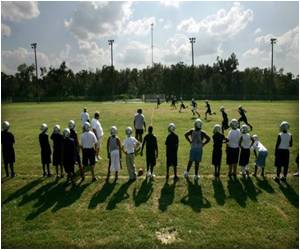High school athletes playing at higher altitudes suffer fewer concussions than those closer to sea-level, shows a new study.

"This is the first time any research has linked altitude to sports-related concussion," said Dawn Comstock, PhD, associate professor of epidemiology at the Colorado School of Public Health and co-author of the study. "It appears that when you are at altitude there may be a little less free space in the skull so the brain can't move around as much."
The study, first-authored by David Smith, MD, of Cincinnati Children's Hospital Medical Center, was published recently in the Orthopaedic Journal of Sports Medicine.
The researchers analyzed concussion statistics from athletes playing multiple sports in 497 high schools from across the U.S. with altitudes ranging from 7 feet to 6,903 feet with 600 feet being the median. They also examined football separately since it has the highest concussion rate of high school sports. The numbers came from the National High School Sports-Related Injury Surveillance System directed by Comstock.
The results showed a 31 percent decrease in concussion rates among all high school sports played at altitudes of 600 feet and above. Concussion rates for high school football players at these altitudes decreased by 30 percent.
"We did see significant differences in concussion rates with elevation changes," Comstock said. "This could mean that kids in Colorado are less likely to sustain a concussion playing sports than kids in Florida."
Advertisement
"Vasogenic edema in the brain leads to increased extravascular water," the study says. "These two adaptations would also lead to a tighter packaging of the brain with increased blood cell content surrounding the brain."
Advertisement
"If this study is correct, we should look to replicate our findings in the National Football League," Comstock said. "For example, if the Broncos play the Chargers in San Diego or the Dolphins in Miami they should experience more concussions than when they play here in Denver."
The incidence of concussion among high school athletes has grown tremendously. The Centers for Disease Control and Prevention estimate the annual incidence of sports-related traumatic brain injury in the U.S. at 1.6 million to 3.8 million with many more going undiagnosed. In a recent 10-year period there has been a 100 percent increase among 8 to 13-year-olds and a 200 percent increase among 14 to 19-year-olds in sports-related emergency room visits for concussion.
Comstock said sports equipment hasn't changed in decades and this study could possibly pave the way for the design of new protective equipment to reduce concussions.
Interestingly, scientists found that putting mild pressure on a rat's jugular vein increased pressure on the brain and reduced injury from concussion by 83 percent.
"There are many possibilities here," Comstock said. "But we are just beginning to understand the connections between altitude and concussion."
Source-Eurekalert









